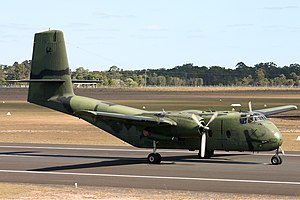De Havilland Canada DHC-4 Caribou
| DHC-4 Caribou | |
|---|---|
 |
|
| A Royal Australian Air Force Caribou at Bundaberg airport. | |
| Role | STOL Transport |
| Manufacturer | de Havilland Canada |
| First flight | 30 July 1958 |
| Introduction | 1961 |
| Retired |
Royal Australian Air Force (2009) United States Army United States Air Force |
| Status | Retired from military operators, limited service |
| Produced | 1958–1968 |
| Number built | 307 |
| Developed into | de Havilland Canada DHC-5 Buffalo |
The de Havilland Canada DHC-4 Caribou (designated by the United States military as the CV-2 and later C-7 Caribou) is a Canadian-designed and produced specialized cargo aircraft with short takeoff and landing (STOL) capability. The Caribou was first flown in 1958 and although mainly retired from military operations, is still in use in small numbers as a rugged "bush" aircraft.
The de Havilland Canada company's third STOL design was a big step up in size compared to its earlier DHC Beaver and DHC Otter, and was the first DHC design powered by two engines. The Caribou, however, was similar in concept in that it was designed as a rugged STOL utility aircraft. The Caribou was primarily a military tactical transport that in commercial service found itself a small niche in cargo hauling. The United States Army ordered 173 in 1959 and took delivery in 1961 under the designation AC-1, which was changed to CV-2 Caribou in 1962.
The majority of Caribou production was destined for military operators, but the type's ruggedness and excellent STOL capabilities requiring runway lengths of only 1200 feet (365 metres) also appealed to some commercial users. U.S. certification was awarded on 23 December 1960. Ansett-MAL, which operated a single example in the New Guinea highlands, and AMOCO Ecuador were early customers, as was Air America, (a CIA front in South East Asia during the Vietnam War era for covert operations). Other civil Caribou aircraft entered commercial service after being retired from their military users.
Today only a handful are in civil use.
In response to a U.S. Army requirement for a tactical airlifter to supply the battlefront with troops and supplies and evacuate casualties on the return journey, de Havilland Canada designed the DHC-4. With assistance from Canada's Department of Defence Production, DHC built a prototype demonstrator that flew for the first time on 30 July 1958.
Impressed with the DHC4's STOL capabilities and potential, the U.S. Army ordered five for evaluation as YAC-1s and went on to become the largest Caribou operator. The AC-1 designation was changed in 1962 to CV-2, and then C-7 when the U.S. Army's CV-2s were transferred to the U.S. Air Force in 1967. U.S. and Australian Caribou saw extensive service during the Vietnam War.
...
Wikipedia
